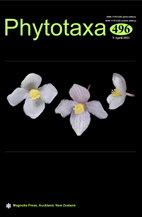Abstract
Pseudostaurosira crateri sp. nov. is described from fossil material analyzed from a Quaternary sediment core retrieved from the Colônia basin (located in the Brazilian Coastal Plain, Atlantic Forest, São Paulo Metropolitan Region). Light and scanning electron microscopy revealed its morphology and enabled its comparison with morphologically similar species from European and African rivers and lakes. The new species features wide and short vimines, a particular characteristic of the genus Pseudostaurosira, in addition to many other exclusive features that distinguish it from any other species in the genus reported to date. Some of these characteristics are: (i) apical pore fields composed of small poroids placed within cavernous troughs carved deep into the valve, (ii) absence of blisters or depositions along the valve mantle edge, (iii) small-sized valve, (iv) presence of incipient or rudimentary spines located on raised virgae at the valve face/mantle junction, and (v) internal accumulations of siliceous material on the volae appearing as concentric discs partially occluding the depression into which the areolae open internally. We further discuss the morphological features of similar species ascribed to the genera Pseudostaurosira, Pseudostaurosiropsis, Staurosirella, Frankophila, and Popovskayella based on literature information. Finally, this study contributes to the knowledge on diatom diversity and its biogeography, especially those from tropical regions, in addition to providing a taxonomical basis for its use as biological markers for paleoenvironmental reconstruction.

